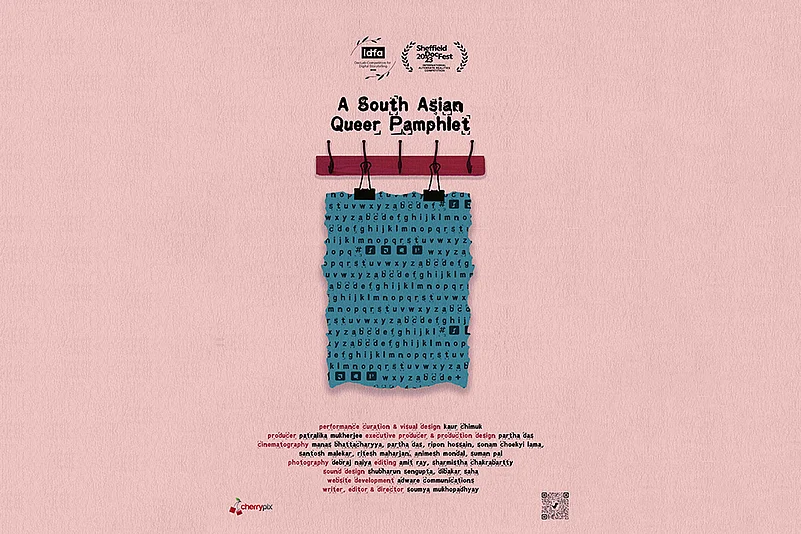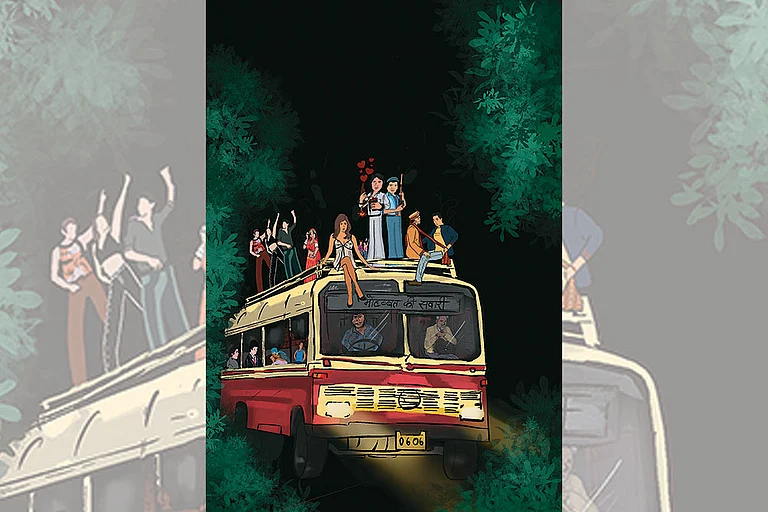The Indian documentary, A South Asian Queer Pamphlet, helmed by director Soumya Mukhopadhyay, earned accolades at two prestigious documentary festivals: the International Documentary Film Festival in Amsterdam (IDFA) and the Sheffield DocFest in London. The film stands out because of its unique approach—an interactive narrative presented through a website. Here, viewers are free to directly engage with the story of Kaur Chimuk, a queer performance artist. This departure from the traditional film format fosters active participation, skilfully bridging the gap between the director and the audience.
Let me guide you through this queer expedition...
In the film, Kaur Chimuk emerges as a solitary, vulnerable figure—an Indian performance artist grappling with the challenge of articulating their queer identity, yearning to connect with the inquisitive ‘other’. Through artistic endeavours, Kaur Chimuk strives to establish a sanctuary for empathetic engagement. Spanning various overlooked corners of South Asia, they reconstruct and reimagine a culture-specific dialogue on postcolonial gender dynamics, drawing inspiration from Judith Butler’s concepts of gender performativity. Their journey commences with a subversion of predominant narratives—historical, political, and cultural—that have long influenced the South Asian region.

The journey unfolds with a captivating scene: a sweeping view of Howrah Bridge, an iconic landmark in old Calcutta, which is bathed in the mellow rays of the rising sun. Against this picturesque backdrop, a humble pamphlet emerges on the screen, featuring the introduction: ‘‘Hi, I am Kaur Chimuk. I hail from Howrah, a city that lies along the west bank of the river Hooghly directly opposite Kolkata, in the eastern part of India. I normally take this cantilever bridge to reach Kolkata. But on this unusually bright monsoon morning, I decided to walk along the river.’’
Thus begins Kaur Chimuk’s odyssey—a journey of self-discovery along the serene banks of the Hooghly River. Mukhopadhyay’s film transcends conventional storytelling; it extends an invitation to the audience to actively participate in Kaur Chimuk’s journey by creating their own pamphlet, thus transforming the viewer into a participant. As Kaur Chimuk strolls along a winding lane in North Kolkata and enters an old printing press, viewers are welcomed to join the experience of crafting their unique word and printing the pamphlet.
As Kaur Chimuk strolls along a lane in North Kolkata and enters an old printing press, viewers are welcomed to join the experience of crafting their unique words.
Upon arrival at the printing press, a prompt appears on screen, inviting viewers to embark on the journey of assembling their personalised visual pamphlet in real-time. The process begins with selecting the colour of the pamphlet, followed by creating a word using a specially designed queer alphabet. On hovering the mouse over each letter, viewers receive hints about the corresponding letter of the English alphabet. Additionally, a glossary of queer performative essays is provided for reference. The machine then deconstructs the word letter by letter, offering a post-cinema experience. Viewers are encouraged to approach this process as a game and to embrace curiosity. Naturally, who wouldn’t be drawn to such a compelling invitation? I enthusiastically joined the game by selecting the letters A-B-S-U-R-D. Upon completing my word and initiating the game, I was transported to a cinematic presentation of Kaur Chimuk’s performance titled ‘‘Appearance’’, which unfolded at the Varanasi Harishchandra Ghat. The performance delves into the connection between outward appearance and gender identification. Set against the backdrop of an open pyre crematorium near the river Ganga in Banaras, Chimuk, clad in a vibrant red sari, looks at their reflection. With a single line of multiple bindis stuck to a mirror, Kaur Chimuk methodically removes and reapplies each one, transforming the straight line of dots into a curvy and non-linear arrangement. As the performance unfolds in a continuous loop, the audio features Kaur Chimuk narrating their life’s predicament in the traditional verse form of Bengal (panchali).
I discovered that the game chose to present “Appearance”, a word from the queer lexicon that starts with ‘A’, and my word “Absurd” also starts with ‘A’. This compelled me to explore further. Returning to the old printing press, I wrote “Nothingness”. This led me to Chimuk’s performance titled “Naturalness”, which depicts the distinction between nature and naturalness concerning gender and sexuality. Set in a forest with dry leaves, a cage, and a green cloak, the performance highlights nature as an originator rather than a procreator. The sound of a caged bird and its fluttering wings evokes the fragile confinement of a queer body.
Continuing to create new words, such as “Dangling”, representing the letter ‘D’, the game unveiled Chimuk’s performance of “Drag.” This act explores how the concept of drag subverts traditional masculine/feminine tropes. Set against the backdrop of a derelict Portuguese church in Goa, Kaur Chimuk performs a hopscotch act as a drag artist.

In conclusion, I crafted my pamphlet with the word “And”, fuelling my curiosity to revisit the game and explore performances associated with other letters like ‘Z’, ‘E’, or ‘L’.
This audio-visual journey intentionally meanders, challenging the linear trajectory often imposed upon our lives and thus reflected in our arts. Each letter creates the necessary word in this queer dictionary that scrutinises the conventional norms governing societal structures, our body politic, and the overarching State apparatus. From the outset, it encourages us to re-evaluate personal experiences and recognise their inherently political dimensions. A South Asian Queer Pamphlet, with its unconventional content and formal experimentation, serves as a catalyst for this introspection, prompting an exploration of the intersection of the personal and the political.
As a viewer, I embarked on a journey through the intricate pathways of Kaur Chimuk’s narrative, evocative of the labyrinthine streets of old Kolkata and ancient Varanasi. It is within these complex paths that individuals uncover their unique dictionary of personal expression.
Enthusiasts of cinema will undoubtedly be captivated by the innovative form of the film’s narrative, where cinematic language is redefined, challenging traditional norms by giving viewers a chance to create their own narrative language.
Debarati Gupta is a Filmmaker, Columnist and Guest Lecturer at the University of Calcutta
(This appeared in the print as 'Cinema Redefined')


















